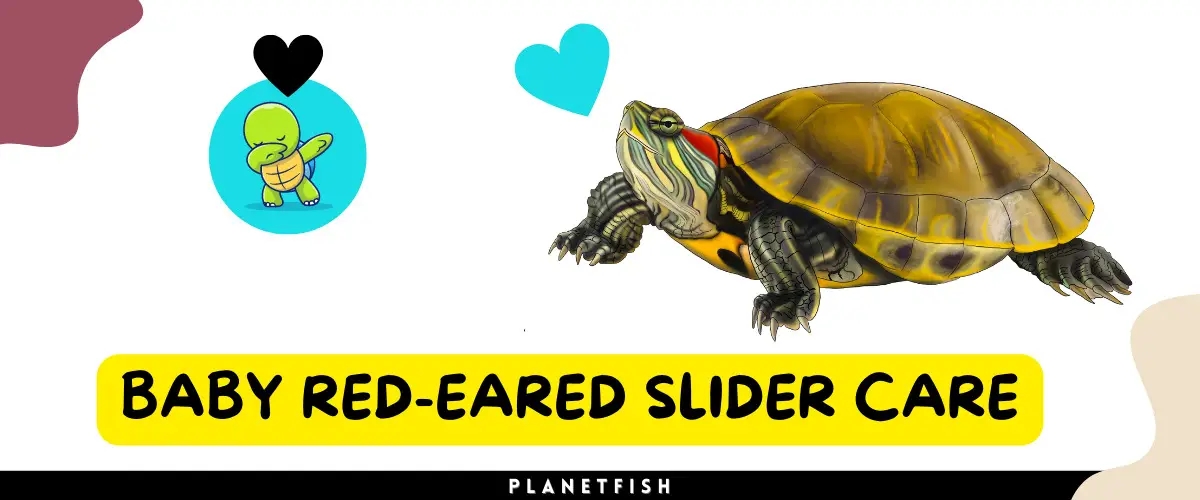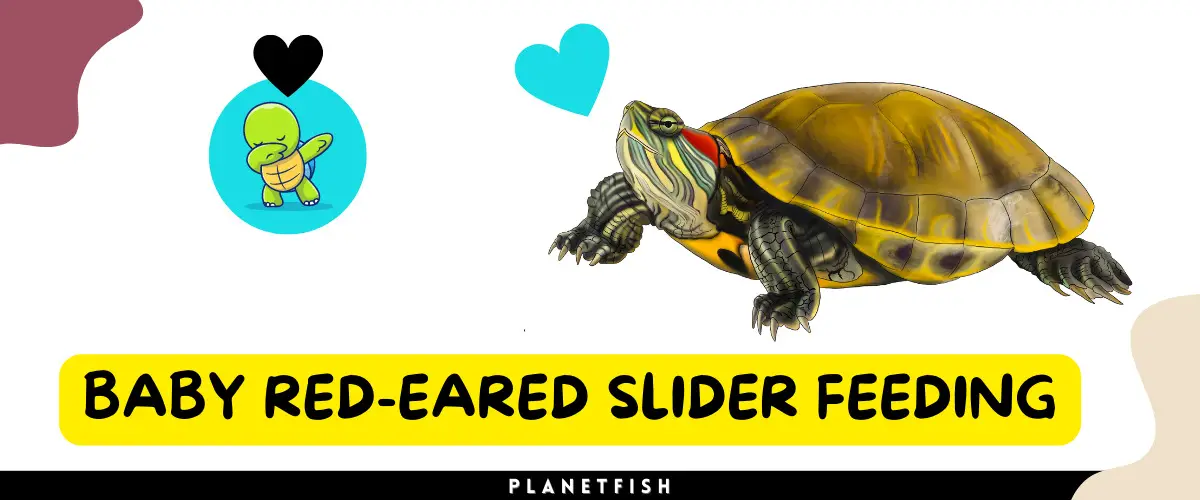When you first purchase a Baby Red-eared slider turtle, it will be more than happy to follow your every move around the tank.
But as with any animal, they need the space to get used to their new home.
They need time to explore and learn about their surroundings. They need to feel safe and secure in order to become tame enough for you to handle them easily.
Here are some tips on how to keep these turtles happy and healthy, from when they’re just a tiny Baby all the way up through adulthood!
If you’re thinking about getting a Baby Red-eared slider turtle, keep in mind that they need time to get used to their new home.

They may not be as active as they are when they’re first born, but they will need time to explore and learn about their surroundings.
Here are some tips on how to keep your Baby Red-eared slider turtle happy and healthy:
1. Provide them with plenty of hiding places in the tank – Baby turtles love to hide under objects, so provide them with a few places where they can do this safely.
2. Give them plenty of food – Baby turtles eat a lot! Feed them small amounts several times a day so that they don’t get too full and start to get lazy.
3. Keep their water clean – make sure to change their water regularly and add fresh vegetables or fruits to their diet if you can.
4. Handle them gently – if you’re going to be handling your turtle often, make sure you do it in a way that doesn’t scare them or force them into dangerous situations.
These are just a few tips to keep your Baby Red-eared slider turtle happy and healthy.
Remember to provide plenty of hiding places, food, and water, and to handle them gently if you’re going to be handling them often.
When it comes to habitat these Baby red-eared slider turtles are quite similar to that Baby-painted turtles.
What is a Baby Red-eared slider turtle?
Baby Red-eared slider turtles are easy to keep and make great pets.

They can be kept in a tank, provided they have plenty of space to swim and bask.
The best way to introduce a Baby slider turtle to its new home is by placing it in an old water dish or bowl, slowly filling it with fresh water, and then slowly transferring the turtle into its new enclosure.
Baby sliders should be fed small feeder fish once a day; live crickets, worms, or other insects can also be offered as food. Adults may eat small amounts of poultry, beef, or other meat, but should not be given high-fat foods.
Why have a pet slider turtle?
If you’re considering adding a slider turtle move to your home, there are a few reasons why they make great pets.
Baby red-eared Sliders are small and low-maintenance animals that can be kept in almost any climate, making them ideal for people who live in apartments or condos.
They also make great beginner pets because they are easy to care for and don’t require much time or money to keep them healthy. Here are five reasons why you should consider adding a slider turtle to your family:
1. Sliders Are Low-Maintenance Pets
Sliders are small and low-maintenance animals that can be kept in almost any climate, making them ideal for people who live in apartments or condos.
They also make great beginner pets because they are easy to care for and don’t require much time or money to keep them healthy.
You can feed them a variety of food items, including frozen bugs, fruits, and vegetables, and they typically only need water once a week if their enclosure is large enough.
If you have trouble keeping other pets clean, slider turtles will be perfect for you because they don’t shed much hair.
2. Sliders Are Easy To Train
One of the things that makes slider turtles such great starter pets is that they are very easy to train.
They usually respond well to gentle discipline, so if you’re looking for an animal that won’t require too much work from you, sliders may be a perfect choice.
Additionally, they are social animals and will enjoy interacting with you and other family members.
3. Sliders Are Friendly
Another thing that makes slider turtles great pets is their friendly nature.
They are usually docile and easy to Handle, making them a great choice for people who are new to pet ownership or those who have trouble with more active pets.
4. Sliders Are Good For Children
One of the reasons why slider turtles make great starter pets is that they are good for children.
They are small enough that children can easily handle them, but they also have some personality traits that make them enjoyable for adults as well.
Slider turtles typically don’t require a lot of exercises, so they’re a good choice if you’re looking for an animal that your child can play with without spending a lot of time turtle running around after it.
5. Sliders Are Good For The Environment
Last but not least, one of the reasons why slider turtles make great pets is because they are good for the environment.
Slider turtles are considered to be some of the most environmentally friendly pet choices because they require very little care and rarely require any veterinary attention.
In addition, they typically live for around 20 years, so they can provide a lot of enjoyment and companionship to their owners over the long term.

How to take care of a Baby Red-eared slider turtle
Red-eared slider Baby turtles are native to the United States and commonly found in freshwater habitats such as ponds, rivers, and creeks.

They are very active turtles that enjoy swimming and sunbathing.
Hatchlings will eat small invertebrates and aquatic plants, but as they get older, they will begin to consume insects, worms, and other small creatures.
Like all turtles, red-eared sliders need a lot of water to stay hydrated. Shellacs usually lose about 2 inches per week so you’ll want to make sure your turtle has access to fresh water at all times.
Red-eared slider babies also need good air circulation in their enclosures so keep the enclosure well-ventilated.
To clean your turtle’s habitat:
- Fill a sink or bucket with cool water and add 1 cup of white vinegar or mild dishwashing soap. Swish the water around until it is clear before filling your turtle’s enclosure.
- Remove any dried leaves, feces, or anything else that may be obstructing your turtle’s view or breathing.
- Wet down one side of the enclosure wall with cool water then spray the surface with a garden hose turned on full blast for about 5 seconds.
- Repeat this process on the other side of the enclosure wall. Be sure to rinse off all soap before letting your turtle back into its habitat.
- To clean your turtle’s dishes: Fill a sink or bucket with cool water and add 1 cup of white vinegar or mild dishwashing soap. Swish the water around until it is clear before filling your turtle’s enclosure.
- Remove any dried leaves, feces, or anything else that may be obstructing your turtle’s view or breathing.
- Wet down one side of the enclosure wall with cool water then spray the surface with a garden hose turned on full blast for about 5 seconds.
- Repeat this process on the other side of the enclosure wall. Be sure to rinse off all soap before letting your turtle back into its habitat.
- Clean the turtle’s food and water dishes with a wet cloth.
- If your turtle is shedding, remove any shed skin with a wet cloth.
- To clean the cage: Fill a sink or bucket with cool water and add 1 cup of white vinegar or mild dishwashing soap. Swish the water around until it is clear before filling your turtle’s enclosure.
How often you should feed your Baby red-eared slider?
If you’re thinking about getting a Baby red-eared slider turtle, here’s a guide for how often to feed it and what food to give it.

Baby red-eared sliders usually eat small invertebrates, such as worms, crickets, and spiders.
You can make a “feeding station” out of some rocks or aquatic plants and put the food in there for the turtle. Make sure to change the food every day so your turtle doesn’t get sick of it.
Baby red-eared sliders need to be fed every two hours while they are still in the water. When they are ready to leave the water, you can continue to feed them every two hours until they are about six months old, but then only once per day.
You can give Baby red-eared sliders water, vegetables, and amphibian food.
Water: Baby red-eared sliders need to be kept hydrated. Give them about a quarter of their body weight in water every day.
Vegetables: Give Baby red-eared sliders vegetables such as lettuce, cucumbers, and zucchini. You can also give them green algae or earthworms.
Amphibian food: Feed Baby red-eared sliders amphibian food such as crickets, mealworms, and small spiders.
Remember to change the turtle’s water and food every day, and give it a variety of things to eat.
If your turtle doesn’t eat or drink enough, it will become sick. Make sure to check its tummy and give it water or food if necessary.
What To Do If They Don’t Eat?
If your Baby red-eared slider turtle doesn’t seem to be getting the nutrition it needs, there are a few things you can do to try and get them to eat.
First, make sure they have access to a variety of food items. Offer them both fresh and wet food options, as well as treats like banana or vegetable slices.
If they still don’t seem interested in eating, try offering them in a different location than their regular home.
Place them in a small container filled with water so that they feel comfortable and safe.
Once they start eating again, make sure you keep an eye on their health so you can make any necessary adjustments to their diet.
If your Baby red-eared slider turtle doesn’t eat, there are a few things you can do to help turtles and get the nutrition they need.
Check the water quality. Make sure the water is clean and clear, and that it has enough fresh-water vegetation for your turtle.
If the water isn’t suitable, give your turtle a different container to live in or provide his own water dish.
Provide a varied diet. Offer your turtle foods that include fresh vegetables and fruits, as well as frozen vegetables and fruit.
Make sure their enclosure is comfortable and safe. Provide a comfortable basking area with plenty of sun exposure, as well as an area where he or she can hide from predators.
Make sure the enclosure is large enough so that your turtle can move around freely but small enough so that he or she doesn’t feel overwhelmed.
If your Baby slider turtle doesn’t seem to be eating properly, there are a few things you can do to help them get their fill.
First and foremost, make sure they have access to a water dish and plenty of fresh air.
Second, try offering them different types of food: cooked vegetables, insects, live prey (if available), or even frozen food.
And finally, keep an eye on their weight and make sure they’re not getting too heavy for their age or size.
![]turtles move](https://live.staticflickr.com/5108/5752134439_2f27b1b2fd_b.jpg)
How to make a tank for your pet Baby Red-eared sliders
If you are looking to keep a Baby red-eared slider turtle, there are a few things you need to know in advance.

Keep in mind that these turtles will grow quickly and may outgrow their tank before you know it.
The minimum size for a red-eared slider tank is 24 inches long, 12 inches wide, and 10 inches deep. The recommended tank size is 30 inches long, 18 inches wide, and 12 inches deep.
If your tank doesn’t meet these specifications, then you should get a larger one. You can either buy an aquarium ready-made or build one yourself.
To create the perfect environment for your new turtle friend, provide plenty of clean water with a good filtration system.
Add live plants to the tank for shade, movement, and oxygenation. Make sure the temperature is appropriate; Red Eared Sliders like warm temperatures between 78-86 degrees Fahrenheit (25-30 degrees Celsius).
Place the tank on an elevated surface so they have some height when they swim around. Lastly, provide food and water dishes so your turtle can easily access them and avoid making messes in your aquarium!
How Big Are Adult Red-Eared Sliders?
Red-eared sliders are one of the most commonly kept turtle species in the pet trade. They can grow to be 3 feet long and weigh around 1 pound, making them relatively small turtles.
This beginner’s guide will cover the basics of owning and caring for a red-eared slider, including feeding and housing requirements.
The red-eared slider is one of the easiest turtles to keep and can make a great pet for beginner turtle enthusiasts.
These resilient creatures can easily be accommodated in a small home setting and are not as picky about their diet as some other turtles.
SIZE: Adult red-eared sliders typically measure between 4 and 6 inches in length, with the females being slightly larger than the males.
LIFE expectancy: Adult red-eared sliders can easily live 10 to 15 years, but they typically only live three to four years in captivity.
HABITAT: Adult red-eared sliders prefer warm climates with plenty of vegetation for hiding and climbing.
They should be provided with a water dish, a basking area (where they can bask in direct sunlight), and an area to bury their eggs if desired.
FEEDING: As with most turtles, a diet of fresh vegetables and fruit is best for red-eared sliders. Feed them small quantities several times per day.
AQUARIUM HOUSING: A minimum size aquarium of 75 gallons is recommended for an adult red-eared slider. Provide a large water dish and plenty of hiding spots for the turtle.
TIPS FOR NEW OWNERS:
1. Be sure to provide a water dish for your turtle and place it in a warm area of the home.
2. Provide a basking area where your turtle can sunbathe during the day.
3. Feed your turtle fresh vegetables and fruit several times per day.
4. Be sure to provide a large water dish for your turtle and plenty of hiding spots
5. Be sure to properly clean your turtle’s enclosure every week to avoid fungal and bacterial infections.
If you are interested in purchasing a red-eared slider, be sure to research the specific requirements for the species before making a purchase.
Do’s and Don’ts of owning a Baby Red-eared slider turtle
Do:
1. Purchase a healthy turtle from a reputable dealer.
2. Get your turtle acclimated to its new home and environment as quickly as possible. A stressed-out turtle will not be able to thrive in a new home.
3. Offer your turtle plenty of food and water, both fresh and salt water, every day. Sliders need about 80-90 grams of food per day, which can be provided in their enclosure or on a dish outside the enclosure.
4. Provide a warm area for your turtle to hibernate during the winter months (between October and April). A basking spot that reaches around 78 degrees Fahrenheit is ideal.
Make sure the temperature remains stable throughout the year by using an automatic thermostat or setting it on “day/night” mode so it doesn’t fluctuate too much between seasons.
5. When handling your turtle, be gentle and avoid pinching its skin; do not grab it by its tail! In addition, never pick up your turtle by holding onto one of its legs – this can cause serious injuries to the spine or internal organs if done incorrectly.
Instead, use two hands to hold onto either side of the shell while gently lifting the animal up off of the ground with ease.
6. If you notice any abnormalities with your turtle – such as decreased appetite, difficulty breathing, lesions, or shedding – take it to see a veterinarian immediately for diagnosis and treatment recommendations.
7. Regularly check your turtle’s feces and water to ensure they are healthy and free of parasites.
8. Be sure to quarantine any new turtles you bring home for at least two weeks to make sure they are not carrying any harmful bacteria or viruses.
Do Not:
1. Keep your turtle in a small, dark enclosure.
2. Attempt to house your turtle with other pets or animals. Sliders are timid and may become aggressive if they feel threatened.
3. Leave your turtle outside in the sun all day long – it will get too hot and sunburned.
4. Use harsh chemicals or cleaners to clean your turtle’s enclosure or water dish. These can be harmful to both you and your turtle.
5. Force your turtle to eat or drink things it does not want to. Some turtles may refuse to eat or drink if they are stressed, so allow them time to adjust to their new environment and diet.
6. Use harsh language or force when disciplining your turtle – this will only make the situation worse.
7. Don’t forget to provide your turtle with a cool place to retreat during the summer months! A shady spot on the patio or in a nearby container of water will do the trick.
8. Never leave your turtle unattended in the home – even for a moment.
What are some pros & cons of owning a Baby red-eared slider turtle?
Some pros of owning a Baby red-eared slider turtle include: they’re very active and entertaining, they’re easy to care for, they’re relatively inexpensive to buy, and their lifespan is typically around 15 years.
Some cons of owning a Baby red-eared slider turtle include: they can be difficult to find due to their popularity as pets, they may require occasional water changes if kept in a humid environment, and they can eat a lot so it’s important to provide them with an adequate food supply.
Owning a Baby red-eared slider turtle is a great way to get your hands on a unique and fun pet. However, there are some pros and cons to consider before making the decision to add one to your family.
Advantages of Owning a Baby Red-Eared Slider Turtle
There are many benefits to owning a Baby red-eared slider turtle, including the fact that they are incredibly cute and relatively easy to care for. They also make excellent pets for children who are interested in learning about wildlife.
Disadvantages of Owning a Baby Red-Eared Slider Turtle
While owning a Baby red-eared slider turtle is certainly not difficult, there are some things that owners need to be aware of.
For example, these turtles require plenty of space in which to move around and can be quite destructive if they’re not given enough room to play.
Additionally, they may require special food and care adjustments if you have other animals living in your home.
Ultimately, the pros and cons of owning a Baby red-eared slider turtle vary depending on the individual turtle. However, it’s generally a good idea to do some research before making any decisions.
How to take care of Baby red-eared sliders’ health
Baby red-eared sliders are becoming increasingly popular pets and are also referred to as painted turtles because of their natural coloring.
They require a lot of attention to ensure they thrive.
The following are some tips on how to take care of Baby red-eared sliders’ health:
- Provide an environment that is warm and humid, with a basking area that reaches at least 80 degrees Fahrenheit.
- Feed them a diet that consists mostly of freshwater and insect larvae.
- Keep their water clean and change it regularly.
- Remove any potential threats such as predators, other pets, and harsh environments.
- Cage them only when necessary and provide them with plenty of toys and hiding spots.
- Provide emotional and physical care to ensure their health and well-being.
Taking care of a Baby red-eared slider is a lot of work, but it is worth it to have a turtle that loves you back. Follow these tips and your turtle will be happy and healthy!
Baby Red-eared slider price
Red-eared slider turtles are some of the most popular turtle species kept as pets.
They come in a variety of colors and sizes, making them easy to find at pet stores. However, like all pets, there are certain things you need to do to take care of their health.
First and foremost, always make sure your turtle has fresh water and a good diet.
Feed them a high-quality commercial turtle food that is balanced and includes both protein and fiber. Also, feed them occasional treats like fresh fruit or vegetables.
Next, be careful when handling your turtle.
Never pull its head backward or pinch its neck – these are signs that it is afraid or angry. If your turtle becomes aggressive, try moving it to a different area of the tank or enclosure so that it can calm down.
Finally, be sure to clean their tanks and enclosures regularly (at least once a week) with warm soapy water and a brush. Don’t use harsh chemicals – they could damage your turtle’s skin
Baby red-eared slider Breeding
There are many things that you need to take care of when breeding Baby red-eared sliders.
One of the most important things is to make sure that their tank is clean and free of any debris. You will also want to provide them with plenty of hiding spots, as they are shy creatures.
When raising these little guys, it is important to pay close attention to their diet. They need high-quality food that includes live and fresh vegetables and insects.
If you are planning on breeding Baby red-eared sliders, make sure to get a tank that is at least 80 gallons in size. You will also need to provide them with a good hiding spot, such as an overturned plant or log.
You should also feed them high-quality food that includes live and fresh vegetables and insects.
Is the Baby red-eared slider recommended for beginners
Baby red-eared sliders are a species of amphibian that needs specific care in order to thrive.

One of the most important things you can do is to keep their environment clean and provide them with the appropriate food and water.
In addition to these basics, here are some tips for keeping your little slider healthy:
- Give your Baby red-eared slider a hiding place during thunderstorms. These amphibians are susceptible to being frightened by loud noises and will not be able to hide if they are inside.
- Do not leave Baby red-eared sliders in direct sunlight for extended periods of time. This can cause them to overheat and die.
- Make sure their water dish is full and change it regularly so that the water stays fresh.
- Do not feed Baby red-eared sliders live insects or other animals, as this can contain harmful bacteria that could kill them.
Overall, Baby red-eared sliders are a species that is best suited for beginners who are willing to take the time to provide them with the proper care.
Best food for Baby red-eared slider
Red-eared slider turtles are known for their sweet and savory taste, making them a favorite food of many people.
There are many different types of food that can be fed to Baby red-eared sliders, but some of the best options include fresh vegetables, fruits, and meat.
It is important to keep in mind that the diet of a Baby red-eared slider should consist mostly of fresh foods. If the turtle gets an occasional treat such as a piece of fruit or a small number of vegetables, it will be happy and healthy.
Baby red-eared sliders also need lots of water to drink, so make sure they have plenty available at all times.
Some of the best food options for Baby red-eared sliders include:
- Fresh vegetables such as cucumbers, carrots, and zucchini
- Fruits such as strawberries, raspberries, and apples
- Meat such as crickets, worms, and beetles
Should you keep the Baby red-eared slider?
Since Baby red-eared sliders are vulnerable to a number of health issues, it is important for you to take care of them properly.
If you are willing to take care of Baby’s red-eared slider with respect to its habitat and food habits then you can keep them.
Here are some tips on how to keep your slider healthy:
1. Keep the water clean. Baby red-eared sliders need clean water in order to stay healthy. Make sure the water you provide is clear and free from debris.
2. Provide a temperature gradient. Baby red-eared sliders need a temperature gradient in their tank in order to regulate their body temperature. Make sure the tank has a warm area and a cool area so your slider can find its ideal temperature range.
3. Provide plenty of hiding spots. Baby red-eared sliders need places to hide and feel safe, which is why they should have plenty of hiding spots in their tank. Make sure the hiding spots are large enough for the slider to fit in comfortably, and make sure they are well-lit so the slider can find its way around easily.
4. Offer food and water regularly. Baby red-eared sliders need food and water to stay healthy, so make sure you offer them both frequently.
5. Clean the tank regularly. Baby red-eared sliders need their tank cleaned regularly in order to keep it clean and free from debris. Make sure to use a natural cleaning product that is safe for your slider’s environment.
Final Thoughts
If you’re interested in adding a Baby Red-eared slider turtle to your family, be sure to do your research first. These turtles can be rewarding pets, but they require plenty of space and care.
If you have any questions about Baby Red-eared slider turtles and how to care for them, please feel free to reach out to us. We would be happy to help!


I like this web site very much, Its a rattling nice billet to
read and find info.Blog monetyze